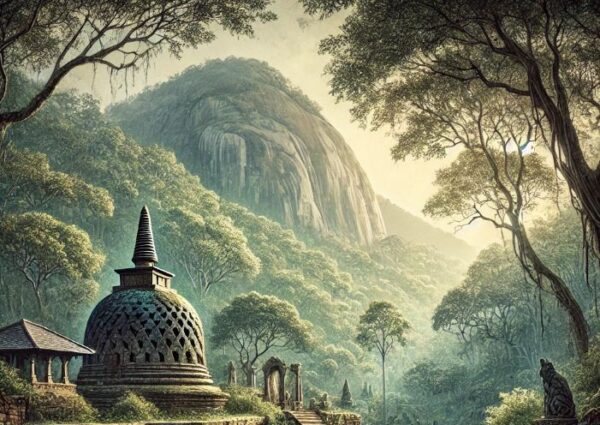Discovering the Mystical Ritigala: A Hidden Gem in Sri Lanka

Ritigala, an ancient monastic site nestled deep within the heart of Sri Lanka, is one of the island’s most mysterious and enchanting destinations. This secluded mountain sanctuary, located about 43 kilometers from the ancient city of Anuradhapura, offers visitors a unique blend of history, spirituality, and natural beauty. Ritigala is not just another archaeological site; it is a place steeped in legends, ancient wisdom, and a deep connection to nature, making it a must-visit for those seeking to explore the hidden treasures of Sri Lanka.
The Legend of Ritigala
Ritigala’s origins are shrouded in myth and folklore. According to local legends, Ritigala is associated with the epic Ramayana, where it is believed that the mountain was used by Hanuman, the monkey god, as a landing site during his quest to find the medicinal herbs needed to heal Lord Rama’s brother, Lakshmana. The mountain’s unique flora, which includes many rare medicinal plants, is often cited as evidence of this ancient tale.
The name “Ritigala” itself is said to be derived from the Sinhala words “Riti,” meaning strict or disciplined, and “Gala,” meaning rock. This name is a fitting description of the ancient monastery that once thrived here, where monks adhered to a strict code of conduct and lived in harmony with the natural surroundings.
The Monastic Complex
Ritigala’s monastic complex dates back to the 1st century BCE, during the reign of King Sena I, who is believed to have established the site as a retreat for Buddhist monks. The monastery was part of the Pabbata Vihara tradition, which emphasized meditation and ascetic practices. Unlike the grand, ornate temples found elsewhere in Sri Lanka, Ritigala’s monastic structures are simple, austere, and seamlessly integrated into the natural environment.
The complex consists of several ancient ruins, including meditation platforms, stone paths, and monastic residences, known as “Kutis.” These structures are scattered across the forested slopes of the mountain, connected by a network of stone-paved walkways. The architecture of Ritigala is unique in that it avoids the typical religious symbols such as stupas or Buddha statues, reflecting the focus on meditation and simplicity.
The Natural Beauty of Ritigala
One of the most striking features of Ritigala is its lush, dense forest, which is home to a diverse range of flora and fauna. The mountain’s elevation creates a microclimate that is cooler and more humid than the surrounding plains, allowing a variety of rare and endemic species to thrive. The forest is teeming with life, from towering trees and exotic orchids to vibrant butterflies and elusive wildlife.
As visitors ascend the mountain, they will pass through different ecological zones, each with its unique plant life. The presence of numerous medicinal plants adds to the mystical aura of Ritigala, and it is easy to see why this site was chosen as a place of healing and spiritual retreat.
The summit of Ritigala offers breathtaking views of the surrounding landscape, with the lush greenery stretching as far as the eye can see. The tranquility and solitude found here make it an ideal place for meditation and introspection, just as it was for the monks who once called this place home.
The Mystique of Ritigala
What sets Ritigala apart from other historical sites in Sri Lanka is its air of mystery. The ruins are largely unmarked and untamed, with nature reclaiming many of the ancient structures. This gives Ritigala a sense of timelessness, as though it exists outside the bounds of ordinary history. Visitors often speak of the spiritual energy that permeates the site, a feeling of stepping into a place where the material world fades away, and the ancient spirits of the forest reign supreme.
The lack of extensive restoration or commercial tourism has preserved Ritigala’s raw and untouched character. This makes a visit to Ritigala a journey into the past, where one can experience the site much as it was centuries ago, free from modern distractions.
Visiting Ritigala
Ritigala is accessible via a short drive from the town of Habarana, making it a convenient day trip for those staying in Anuradhapura, Polonnaruwa, or Sigiriya. The hike to the monastic complex is moderately challenging, with a well-maintained path leading through the forest. While the site is open to visitors, it remains relatively uncrowded, offering a peaceful and reflective experience.
As you explore Ritigala, it is important to respect the sanctity of the site. The ruins are fragile, and the forest is home to many delicate ecosystems. Visitors are encouraged to tread lightly, taking only photographs and leaving nothing but footprints.
Conclusion
Ritigala is a hidden gem in Sri Lanka’s cultural and natural heritage. It is a place where history, spirituality, and nature come together in perfect harmony, offering a unique and enriching experience for those who venture off the beaten path. Whether you are a history enthusiast, a nature lover, or a spiritual seeker, Ritigala has something to offer. Its mystical allure and untouched beauty make it a destination that lingers in the heart and mind long after the journey has ended.





















